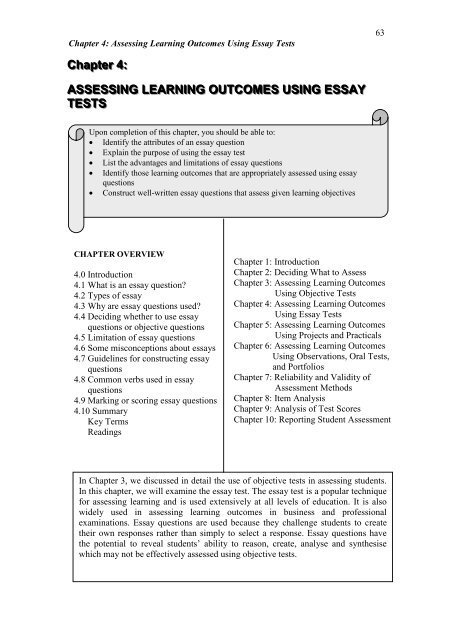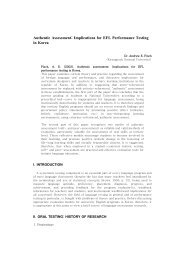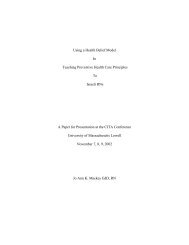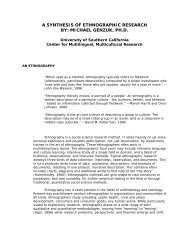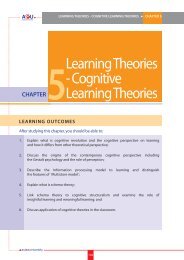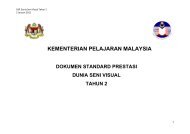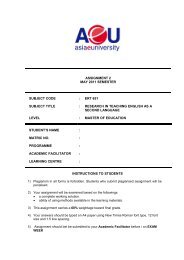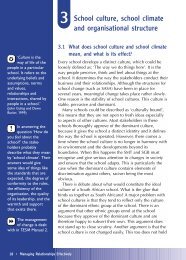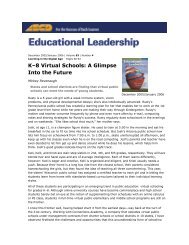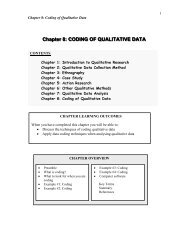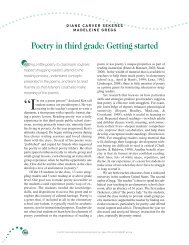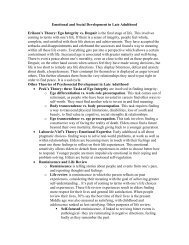Chapter 4: Assessing Learning Outcomes using Essay Tests
Chapter 4: Assessing Learning Outcomes using Essay Tests
Chapter 4: Assessing Learning Outcomes using Essay Tests
You also want an ePaper? Increase the reach of your titles
YUMPU automatically turns print PDFs into web optimized ePapers that Google loves.
<strong>Chapter</strong> 4: <strong>Assessing</strong> <strong>Learning</strong> <strong>Outcomes</strong> Using <strong>Essay</strong> <strong>Tests</strong><br />
63<br />
Chaptter 4::<br />
ASSESSIING LEARNIING OUTCOMES USIING ESSAY<br />
TESTS<br />
Upon completion of this chapter, you should be able to:<br />
Identify the attributes of an essay question<br />
Explain the purpose of <strong>using</strong> the essay test<br />
List the advantages and limitations of essay questions<br />
Identify those learning outcomes that are appropriately assessed <strong>using</strong> essay<br />
questions<br />
Construct well-written essay questions that assess given learning objectives<br />
CHAPTER OVERVIEW<br />
4.0 Introduction<br />
4.1 What is an essay question?<br />
4.2 Types of essay<br />
4.3 Why are essay questions used?<br />
4.4 Deciding whether to use essay<br />
questions or objective questions<br />
4.5 Limitation of essay questions<br />
4.6 Some misconceptions about essays<br />
4.7 Guidelines for constructing essay<br />
questions<br />
4.8 Common verbs used in essay<br />
questions<br />
4.9 Marking or scoring essay questions<br />
4.10 Summary<br />
Key Terms<br />
Readings<br />
<strong>Chapter</strong> 1: Introduction<br />
<strong>Chapter</strong> 2: Deciding What to Assess<br />
<strong>Chapter</strong> 3: <strong>Assessing</strong> <strong>Learning</strong> <strong>Outcomes</strong><br />
Using Objective <strong>Tests</strong><br />
<strong>Chapter</strong> 4: <strong>Assessing</strong> <strong>Learning</strong> <strong>Outcomes</strong><br />
Using <strong>Essay</strong> <strong>Tests</strong><br />
<strong>Chapter</strong> 5: <strong>Assessing</strong> <strong>Learning</strong> <strong>Outcomes</strong><br />
Using Projects and Practicals<br />
<strong>Chapter</strong> 6: <strong>Assessing</strong> <strong>Learning</strong> <strong>Outcomes</strong><br />
Using Observations, Oral <strong>Tests</strong>,<br />
and Portfolios<br />
<strong>Chapter</strong> 7: Reliability and Validity of<br />
Assessment Methods<br />
<strong>Chapter</strong> 8: Item Analysis<br />
<strong>Chapter</strong> 9: Analysis of Test Scores<br />
<strong>Chapter</strong> 10: Reporting Student Assessment<br />
In <strong>Chapter</strong> 3, we discussed in detail the use of objective tests in assessing students.<br />
In this chapter, we will examine the essay test. The essay test is a popular technique<br />
for assessing learning and is used extensively at all levels of education. It is also<br />
widely used in assessing learning outcomes in business and professional<br />
examinations. <strong>Essay</strong> questions are used because they challenge students to create<br />
their own responses rather than simply to select a response. <strong>Essay</strong> questions have<br />
the potential to reveal students‟ ability to reason, create, analyse and synthesise<br />
which may not be effectively assessed <strong>using</strong> objective tests.
<strong>Chapter</strong> 4: <strong>Assessing</strong> <strong>Learning</strong> <strong>Outcomes</strong> Using <strong>Essay</strong> <strong>Tests</strong><br />
64<br />
4.1 WHAT IS AN ESSAY QUESTION?<br />
According to Stalnaker (1951), an<br />
essay is “a test item which requires a response<br />
composed by the examinee usually in the form<br />
of one or more sentences of a nature that no<br />
single response or pattern of responses can be<br />
listed as correct, and the accuracy and quality<br />
of which can be judged subjectively only by<br />
one skilled or informed in the subject”.<br />
Though the definition was provided a long<br />
time ago, it is a comprehensive definition.<br />
Elaborating on this definition, Reiner, Bothell,<br />
Sudweeks and Wood (2002), argued that to<br />
qualify as an essay question it should meet the<br />
following FOUR criteria:<br />
Figure 4.1 Learner composes an<br />
answer that consists of one or more<br />
sentences<br />
1. The learner has to compose rather than select his or her response or answer.<br />
In essay questions, students have to construct their own answer and decide on<br />
what material to include in their response. Objective test questions (MCQ,<br />
true-false, matching) require students to select the answer from a list of<br />
possibilities.<br />
2. The response or answer the learner provides will consist of one or more<br />
sentences. Students do not respond with a “yes” or “no” response but instead<br />
have to respond in the form of sentences. In theory there is no limit to the<br />
length of the answer. However, in most cases its length is predetermined by<br />
the demands of the questions and the time limit allotted for the question.<br />
3. There is no one single correct response or answer. In other words, the<br />
question should be composed so that it does not ask for one single correct<br />
response. For example, the question, “Who killed J.W.W. Birch?” assesses<br />
verbatim recall or memory and not the ability to think. Hence, it cannot<br />
qualify as an essay question. You could modify the question, “Who killed<br />
J.W.W. Birch and explain the factors that led to the killing?”. Now, it is an<br />
essay question that assesses students‟ ability to think and give reasons for the<br />
killing supported with relevant evidence.<br />
4. The accuracy and quality of students‟ responses or answers to essays must be<br />
judged subjectively by a specialist in the subject: The nature of essay<br />
questions is such that only specialists in the subject can judge to what degree<br />
responses (or answers) to an essay are complete, accurate and relevant. Good<br />
essay questions encourage students to think deeply about their answers that<br />
can only judged by someone with the appropriate experience and expertise in<br />
the content area. Thus, content expertise is essential for both writing and<br />
grading essay questions. For example, the question “List three reasons for the
<strong>Chapter</strong> 4: <strong>Assessing</strong> <strong>Learning</strong> <strong>Outcomes</strong> Using <strong>Essay</strong> <strong>Tests</strong><br />
65<br />
opening of Penang by the British in 1789” requires students to recall a set list<br />
of items. The person marking or grading the essay does not have to be a<br />
subject matter expert to know if the student has listed the three reasons<br />
correctly as long as the list of three reasons is available as an answer key. For<br />
the question, “To what extent is commerce the main reason for the opening of<br />
Penang by the British in 1789?”, a subject-matter expert is needed to grade or<br />
mark an answer to this essay question.<br />
4.2 TYPES OF ESSAYS<br />
Generally, there are two types of essays; the coursework essay and the examination<br />
essay which are used in educational institutions:<br />
WHAT IS A COURSEWORK ESSAY?<br />
The coursework essay may consist of the following:<br />
<strong>Essay</strong> Outlines: These is a short summary or outline of a particular topic<br />
(perhaps, about 500 words). It assesses the ability to organise material, to<br />
construct coherent arguments, to select relevant information from a wide field<br />
of study.<br />
Standard essays: These are full papers of anything from 1000 to 2500 words<br />
in length. They assess the ability to describe to analyse the relationship<br />
between ideas and events, to give a coherent account of a topic, to select and<br />
to weigh evidence in support of an argument, to diagnose and to suggest<br />
solutions to problems, to solve familiar types of problems, to solve familiar<br />
types of problems, to express critical judgements and to make comparisons.<br />
Extended essays: These are full papers of between 2500 to 5000 words in<br />
length. They assess the ability to solve less familiar problem and to analyse or<br />
critically evaluate less familiar materials. Hence, requiring more extensive<br />
preparation or research.<br />
Coursework essays are intended to assess students‟ ability to research a topic<br />
thoroughly and meticulously, and to handle a mass of material. It evaluates their<br />
ability to answer at length (“Give them enough rope…..”) on a chosen topic. Of<br />
particular concern are the points the student makes, how he or she has related them,<br />
the way in which his or her essay is organised, the value he or she attaches to different<br />
aspects of the topic. Coursework essays are a written response and students are<br />
expected, for the most part, to use their own words and communicate their ideas<br />
clearly and persuasively.<br />
WHAT IS AN EXAMINATION ESSAY?<br />
This is the short essay written as part of a formal examination [Surely you<br />
have had experience with this format of assessment!]. For example, in a 2-3 hour<br />
examination, students may be required to answer about three essay questions allotting<br />
about 35-45 minutes per question. In practice, there is much variation in the number<br />
of questions asked and duration of the examination. In some situations there is a<br />
choice of questions while in other situations there is no choice. The reason for<br />
controlling choice is to ensure that students are examined over a comparable range [In
<strong>Chapter</strong> 4: <strong>Assessing</strong> <strong>Learning</strong> <strong>Outcomes</strong> Using <strong>Essay</strong> <strong>Tests</strong><br />
66<br />
this chapter we will focus on the „Examination <strong>Essay</strong>‟; i.e. the use of essay questions<br />
in examinations which is commonly a „close-book‟ setting. We will discuss further<br />
about the Coursework <strong>Essay</strong> in <strong>Chapter</strong> 5 under Projects].<br />
examinations.<br />
4.1 ACTIVITY<br />
Select a few essay questions used as tests in you subject area<br />
To what extent do these questions meet the criteria of an<br />
essay defined by Stalnaker (1951) and elaborated by Reiner,<br />
Bothell, Sudweeks and Wood (2002).<br />
4.3 WHY ARE ESSAY QUESTIONS USED?<br />
<strong>Essay</strong> questions are used to assess learning because of the following reasons:<br />
<br />
<strong>Essay</strong> questions provide an effective way of assessing complex learning<br />
outcomes. They allow one to assess<br />
students' ability to synthesise ideas, to<br />
organise, and express ideas and to evaluate<br />
Price is determined<br />
by supply and<br />
the worth of ideas. These abilities cannot<br />
demand. When there<br />
be effectively assessed directly with other<br />
is a shortage of…….<br />
paper-and-pencil test items.<br />
<strong>Essay</strong> questions allow students to<br />
demonstrate their reasoning. <strong>Essay</strong><br />
questions not only allow students to<br />
present an answer to a question but also to<br />
explain how they arrived at their<br />
conclusion. This allows teachers to gain<br />
insights into a student's way of viewing<br />
and solving problems. With such insights,<br />
teachers are able to detect problems<br />
students may have with their reasoning<br />
process and help them overcome those<br />
problems.<br />
Figure 4.1 The reasoning<br />
process of a learner is<br />
reflected in the answer<br />
<br />
<strong>Essay</strong> questions provide authentic experiences. „Constructing responses‟ are<br />
closer to real life than selecting responses (as in the case of objective tests).<br />
Problem solving and decision-making are vital life competencies which<br />
require the ability to construct a solution or decision rather than selecting a<br />
solution or decision from a limited set of possibilities. In the world of work it<br />
is unlikely that an employer will give a list of „four options‟ for the worker to<br />
choose from when asked to solve a problem! In most cases, the worker will be<br />
required to construct a response. Hence, essay items are closer to real life than<br />
objective test question because in real life students typically construct<br />
responses, not select them.
<strong>Chapter</strong> 4: <strong>Assessing</strong> <strong>Learning</strong> <strong>Outcomes</strong> Using <strong>Essay</strong> <strong>Tests</strong><br />
67<br />
4.2 ACTIVITY<br />
Compare the following two essay questions and decide<br />
which one assesses higher-order thinking skills.<br />
What are the major advantages and limitations of <strong>using</strong><br />
nuclear solar energy?<br />
Given its advantages and limitations, should governments<br />
spend money developing nuclear energy?<br />
4.4 DECIDING WHETHER TO USE ESSAY QUESTIONS OR<br />
OBJECTIVE QUESTIONS<br />
The decision whether to use essay questions<br />
or objective questions in examinations can be<br />
problematic for some educators. In such a situation<br />
one has to go back to the objectives of assessment.<br />
What kinds of learning outcomes do you intend to<br />
assess? <strong>Essay</strong> questions are generally suitable for<br />
the following purposes:<br />
To assess students' understanding of<br />
<br />
subject-matter content<br />
To assess thinking skills that require<br />
more than simple verbatim recall of<br />
information by challenging the students to reason with their<br />
knowledge.<br />
However, students‟ understanding of subject-matter content and many of the<br />
other higher-order thinking skills could also be assessed through objective items.<br />
When in doubt as to whether to use an essay question or an objective question, just<br />
remember that essay questions are used to assess students' ability to construct rather<br />
than select answers.<br />
To determine what type of test (essay or objective) to use, it is helpful that you<br />
examine the verb(s) that best describe the desired ability to be assessed [We discussed<br />
these verbs in <strong>Chapter</strong> 2]. These verbs indicate what students are expected to do and<br />
how they should respond. These verbs serve to channel and focus the student<br />
responses towards the performance of specific tasks. Some verbs clearly indicate that<br />
students need to construct rather than select their answer (e.g. to explain). Other verbs<br />
indicate that the intended learning outcome is focused on students‟ ability to recall<br />
information (e.g. to list). Perhaps, recall is best assessed through objectively-scored<br />
items. Verbs that test for understanding of subject-matter content or other forms of<br />
higher-order thinking but do not specify whether the student is to construct or to select<br />
the response (e.g. to interpret) can be assessed either by essay questions or by<br />
objective items.
<strong>Chapter</strong> 4: <strong>Assessing</strong> <strong>Learning</strong> <strong>Outcomes</strong> Using <strong>Essay</strong> <strong>Tests</strong><br />
68<br />
4.3 ACTIVITY<br />
a) Do you agree with the reasons for <strong>using</strong> essay tests in your<br />
subject area?<br />
b) Compare, explain, arrange, apply, state, classify, design,<br />
illustrate, describe, name, complete, choose, defend, name.<br />
Decide which of the above list of verbs is best assessed by<br />
essay tests or objective tests or both objective and essay<br />
tests.<br />
4.5 WHAT ARE SOME LIMITATIONS OF ESSAY QUESTIONS?<br />
While essay questions are popular because they enable the assessment of higher-order<br />
learning outcomes, this format of evaluating students in examinations has a number of<br />
limitations which should be kept in mind.<br />
<br />
<br />
<br />
One purpose of testing is to assess a student's mastery of the subject matter. In<br />
most cases it is not possible to assess the student's mastery of the complete<br />
subject matter domain with just a few questions. Because of the time it takes<br />
for students to respond to essay questions and for markers to mark students'<br />
responses, the number of essay questions that can be included in a test is<br />
limited. Therefore, <strong>using</strong> essay questions will limit the degree to which the test<br />
is representative of the subject-matter domain thereby reducing content<br />
validity. For instance, a test of 80 multiple-choice questions will most likely<br />
cover more of the content domain than a test of 3-4 essay questions<br />
<strong>Essay</strong> questions have limitations in reliability. While essay questions allow<br />
students some flexibility in formulating their responses, the reliability of<br />
marking or grading is questionable.<br />
Different markers or graders may vary in<br />
their marking or grading of the same or<br />
similar responses (interscorer reliability)<br />
and one marker can vary significantly in<br />
his or her marking or grading consistency<br />
across questions depending on many<br />
factors (intrascorer reliability).<br />
Therefore, essay answers of similar<br />
- Interscorer reliability<br />
is low.<br />
- Limited amount of the<br />
subject matter tested<br />
- Time consuming<br />
quality may receive notably different scores. Characteristics of the learner,<br />
length and legibility of responses, and personal preferences of the marker or<br />
grader with regards to the content and structure of the response are some of the<br />
factors that may lead to unreliable marking or grading.<br />
<strong>Essay</strong> questions require more time for marking student responses. Teachers<br />
need to invest large amounts of time to read and mark students‟ responses to
<strong>Chapter</strong> 4: <strong>Assessing</strong> <strong>Learning</strong> <strong>Outcomes</strong> Using <strong>Essay</strong> <strong>Tests</strong><br />
69<br />
essay questions. On the other hand relatively little or no time is required of<br />
teachers for scoring objective test items like multiple-choice items, matching<br />
exercises, etc.<br />
As mentioned earlier, one of the strengths of essay questions is that they provide<br />
students with authentic experiences because students are challenged to construct<br />
rather than to select their responses. To what extent does the short time given affect<br />
student response? Students have relatively little time to construct their responses and<br />
it does not allow them to give appropriate attention to the complex process of<br />
organizing, writing, and reviewing their responses. In fact, in responding to essay<br />
examinations.<br />
4.4 ACTIVITY<br />
a) Do you agree with the weaknesses of the essay<br />
with regards to your subject areas?<br />
b) Identify other weaknesses of the essay as an examination<br />
test in your subject area.<br />
questions, students use a writing process that is quite different from the typical<br />
process that produces excellent writing (draft, review, revise, evaluate, etc.). In<br />
addition students usually have no resources to aid their writing when answering essay<br />
questions (dictionary, thesaurus, etc.). This disadvantage may offset whatever<br />
advantage accrued from the fact that responses to essay questions are more authentic<br />
than responses to multiple-choice items.<br />
4.6 SOME MISCONCEPTIONS ABOUT ESSAY QUESTIONS IN<br />
EXAMINATIONS<br />
Besides the limitations of essay questions, there are also some misconceptions about<br />
this format of assessment:<br />
By their very nature essay questions assess higher-order thinking. Whether<br />
or not an essay item assesses higher-order thinking depends on the design of<br />
the question and how students‟ responses are scored. An essay question does<br />
not automatically assess higher-order thinking skills. It is possible to write<br />
essay questions that simply assess recall. Also, if a teacher designs an essay<br />
question meant to assesses higher-order thinking but then scores students‟<br />
responses in a way that only rewards recall ability, that teacher is not assessing<br />
higher-order thinking.<br />
<br />
<br />
<strong>Essay</strong> questions are easy to construct. <strong>Essay</strong> questions are easier to construct<br />
than multiple-choice items because teachers do not have to create effective<br />
distractors. However, that does not mean that good essay questions are easy to<br />
construct. They may be easier to construct in a relative sense, but they still<br />
require a lot of effort and time. <strong>Essay</strong> questions that are hastily constructed<br />
without much thought and review usually function poorly.<br />
The use of essay questions eliminates the problem of guessing. One of the<br />
drawbacks of objective test items is that students sometimes get the right
<strong>Chapter</strong> 4: <strong>Assessing</strong> <strong>Learning</strong> <strong>Outcomes</strong> Using <strong>Essay</strong> <strong>Tests</strong><br />
70<br />
answer by guessing which of the presented options is correct. This problem<br />
does not exist with essay questions because students need to generate the<br />
answer rather than identifying it from a set of options provided. At the same<br />
time, the use of essay questions introduces bluffing, another form of guessing.<br />
Some students are „good‟ at <strong>using</strong> various methods of bluffing (vague<br />
generalities, padding, name-dropping, etc.) to add credibility to an otherwise<br />
weak answer. Thus, the use of essay questions changes the nature of the<br />
guessing that occurs, but does not eliminate it.<br />
<br />
<br />
<strong>Essay</strong> questions benefit all students by placing emphasis on the importance<br />
of written communication skills. Written communication is a life competency<br />
that is required for effective and successful performance in many vocations.<br />
<strong>Essay</strong> questions challenge students to organise and express subject matter and<br />
problem solutions in their own words, thereby giving them a chance to<br />
practice written communication skills that will be helpful to them in future<br />
vocational responsibilities. At the same time, the focus on written<br />
communication skills is also a serious disadvantage for students who have<br />
marginal writing skills but know the subject-matter being assessed. To the<br />
degree that students who are knowledgeable in the subject obtain low scores<br />
because of their inability to write well, the validity of the test scores will be<br />
diminished.<br />
<strong>Essay</strong> questions encourage students to prepare more thoroughly. Some<br />
research seems to indicate that students are more thorough in their preparation<br />
for essay questions that in their preparation for objective examinations like<br />
multiple choice questions. However, after an extensive review of existing<br />
literature and research on this topic, Crook (1988) concluded that students<br />
prepare more based on the expectations teachers set upon them (higher-order<br />
thinking and breadth and depth of content) than they do by the type of test<br />
question they expect to be given.<br />
people h<br />
4.5 ACTIVITY<br />
a) To what extent do you agree with the misconceptions<br />
with regards to essay questions?<br />
b) Can you identify other common misconceptions or myths<br />
about essay questions?<br />
4.7 SOME GUIDELINES FOR CONSTRUCTING ESSAY<br />
QUESTIONS<br />
When constructing essay questions, whether it be for Coursework Assessment or<br />
Examinations, the most important thing is to ENSURE THAT STUDENTS HAVE<br />
A CLEAR IDEA ON WHAT THEY ARE EXPECTED TO DO AFTER THEY<br />
HAVE READ THE QUESTION OR PROBLEM PRESENTED.
<strong>Chapter</strong> 4: <strong>Assessing</strong> <strong>Learning</strong> <strong>Outcomes</strong> Using <strong>Essay</strong> <strong>Tests</strong><br />
71<br />
Below are specific guidelines that can help you improve existing essay questions and<br />
create new ones.<br />
1. Clearly Define the Intended <strong>Learning</strong> Outcome to be Assessed by the<br />
Question.<br />
Knowing the intended learning outcome is crucial for designing essay questions. some<br />
skill, ability, or trait other than the one intended. In specifying the intended learning<br />
outcome teachers clarify the performance that students should be able to demonstrate<br />
as a result of what they have learned. The intended learning outcome typically begins<br />
with a verb that describes an observable behavior, action or outcome that students<br />
should demonstrate. The focus is on what students should be able to do and not on the<br />
learning or teaching process. Reviewing a list of verbs can help to clarify what ability<br />
students should demonstrate and to clearly define the intended learning outcome to be<br />
assessed.<br />
Example:<br />
<strong>Learning</strong> Outcome: To be able to differentiate the reproductive habits of birds and<br />
amphibians<br />
<strong>Essay</strong> Question: What are the differences in egg laying characteristics between<br />
birds and amphibians?<br />
Note: This learning outcome can be better assessed by an objective test<br />
Objective Item:<br />
Which of the following differences between birds and amphibians is correct?<br />
Birds<br />
Amphibians<br />
A Lay a few eggs at a time Lay many eggs at a time<br />
B Lay eggs Gives birth<br />
C Do not incubate eggs Incubate eggs<br />
D Lay eggs in nest Lay eggs on land<br />
2. Avoid Using <strong>Essay</strong> Questions for Intended <strong>Learning</strong> <strong>Outcomes</strong> that are<br />
Better Assessed with other Kinds of Assessment.<br />
Some types of learning outcomes can be more efficiently and more reliably assessed<br />
with objective tests than with essay questions. Since essay questions sample a limited<br />
range of subject-matter content, are more time consuming to score, and involve<br />
greater subjectivity in scoring, the use of essay questions should be reserved for<br />
learning outcomes that cannot be better assessed by some other means.
<strong>Chapter</strong> 4: <strong>Assessing</strong> <strong>Learning</strong> <strong>Outcomes</strong> Using <strong>Essay</strong> <strong>Tests</strong><br />
72<br />
3. Clarity about the Task and Scope.<br />
<strong>Essay</strong> questions have two variable elements—the degree to which the task is<br />
structured and the degree to which the scope of the content is focused. There is still<br />
confusion among educators whether more structure of the task required and more<br />
focus on the content are better than less structure and less focus. When the task is<br />
more structured and the scope of content is more focused two problems are reduced:<br />
<br />
<br />
the problem of student responses containing ideas that were not meant to be<br />
assessed,<br />
the problem of extreme subjectivity when scoring student answers or<br />
responses.<br />
Although more structure helps to avoid these problems, how much and what<br />
kind of structure and focus to provide is dependent on the intended learning outcome<br />
that is to be assessed by the essay question. The process of writing effective essay<br />
questions involves defining the task and delimiting the scope of the content in an<br />
effort to create an effective question that is aligned with the intended learning<br />
outcome to be assessed by it (see Figure 4.1).<br />
INFORMATION<br />
DESIGN<br />
LEARNING<br />
OUTCOMES<br />
BODY OF<br />
CONTENT<br />
LEARNING<br />
ACTIVITIES<br />
ASSESSMENT<br />
TASKS<br />
INTERACTION<br />
DESIGN<br />
Figure 4.1 Alignment between Content, <strong>Learning</strong><br />
<strong>Learning</strong> Activities and Assessment Tasks<br />
[source: John A. Phillips, Ansary Ahmed & Kuldip Kaur , 2005. Instructional Design<br />
Principles in the Development of an E-<strong>Learning</strong> Graduate Course. Paper presented<br />
at The International Conference in E-<strong>Learning</strong>. Bangkok, Thailand.
<strong>Chapter</strong> 4: <strong>Assessing</strong> <strong>Learning</strong> <strong>Outcomes</strong> Using <strong>Essay</strong> <strong>Tests</strong><br />
73<br />
Example:<br />
IMPROVING CLARITY OF TASK AND<br />
SCOPE OF ESSAY QUESTIONS<br />
Weak essay question:<br />
Evaluate the impact of the Industrial Revolution on England.<br />
The verb is “evaluate” which is the task the student is supposed to do. The scope of<br />
the question is the impact of the Industrial Revolution on England. Very little<br />
guidance is given to students about the task of evaluating and the scope of the task.<br />
A student reading the question may ask:<br />
the impact on what in England? The economy? Foreign trade? A<br />
particular group of people? [The scope is not clear].<br />
evaluate based on what criteria? The significance of the revolution?<br />
The quality of life in England? Progress in technological<br />
advancements? [The task is not clear].<br />
what exactly do you want me to do in my evaluation? [The task is<br />
not clear]<br />
Improved essay question:<br />
Evaluate the impact of the Industrial Revolution on the quality of<br />
family life in England. Explain whether families were able to provide<br />
for the education of their children.<br />
The improved question delimits the task for students by specifying a particular unit<br />
of society in England affected by the Industrial Revolution (family). The task is<br />
also delimited by giving students a criterion for evaluating the impact of the<br />
Industrial Revolution (whether or not families were able to provide for their<br />
children‟s education. Students are clearer as to what must be done to “evaluate.”<br />
They need to explain how the family has changed and judge whether or not the<br />
changes are an improvement for their children.<br />
[source: adaptation: C.M. Reiner, T.W. Bothell, R.R. Sudweeks & B. Wood<br />
Preparing Effective <strong>Essay</strong> Questions. 2002 New Forums Press<br />
This alignment is absolutely necessary for obtaining student responses that can<br />
be accepted as evidence that a student has achieved the intended learning outcome.<br />
Hence, the essay question must be carefully and thoughtfully written in such a way<br />
that it elicits student responses that provide the teacher with valid and reliable<br />
evidence about the students‟ achievement of the intended learning outcome. Failure to<br />
establish adequate and effective limits for student answers to the essay question may<br />
result in students setting their own boundaries for their responses. This means that<br />
students might provide answers that are outside the intended task or address only a<br />
part of the intended task. If this happens then the teacher is left with unreliable and<br />
invalid information about the students‟ achievement of the intended learning outcome.
<strong>Chapter</strong> 4: <strong>Assessing</strong> <strong>Learning</strong> <strong>Outcomes</strong> Using <strong>Essay</strong> <strong>Tests</strong><br />
74<br />
Also, there is no basis for marking or grading student‟s answers. Therefore, it is the<br />
responsibility of the teacher to write essay questions in such a way that they provide<br />
students with clear boundaries for their answers or responses.<br />
SELF-CHECK 4.1<br />
a) When would you decide to use an objective test item rather<br />
than an essay test to assess learning?<br />
b) What is the difference between the task and scope of an<br />
essay question?<br />
4. Questions that are Fair<br />
One of the challenges that teachers face in composing essay questions is that<br />
because of their extensive experience with the subject matter they may be tempted to<br />
demand unreasonable content expertise on the part of the students. Hence, teachers<br />
need to make sure that their students can “be expected to have adequate material with<br />
which to answer the question.” (Stalnaker, 1952, p.52). In addition, teachers should<br />
ask themselves if students can be reasonably expected to adequately perform the<br />
thought processes which are required of them in the task. For assessment to be fair,<br />
teachers need to provide their students with sufficient instruction and practice in the<br />
subject matter and the thought processes to be assessed.<br />
Another important element is to avoid <strong>using</strong> indeterminate questions. A<br />
question is indeterminate if it is so unstructured that students can redefine the problem<br />
and focus on some aspect of it with which they are thoroughly familiar, or if experts<br />
in the subject matter cannot agree that one answer is better than another. One way to<br />
avoid indeterminate questions is to stay away from vocabulary that is ambiguous. For<br />
example, teachers should avoid <strong>using</strong> the verb “discuss” in an essay question. This<br />
verb simply is too broad and vague. Moreover, teachers should also avoid including<br />
vocabulary that is too advanced for students.<br />
5. Specify the approximate time limit and marks allotted for each question<br />
Specifying the approximate time limit helps students allocate their time in answering<br />
several essay questions. Without such guidelines students may feel at a loss as to how<br />
much time to spend on a question. When deciding the guidelines for how much time<br />
should be spent on a question keep the slower students and students with certain<br />
disabilities in mind. Also make sure that students can be realistically expected to<br />
provide an adequate answer in the given and/or suggested time. Similarly, state the<br />
marks allotted for each questions so that students can decide how much they should<br />
write about a questions.<br />
6. Use several relatively short essay questions rather than one long one.<br />
Only a very limited number of essay questions can be included on a test because of<br />
the time it takes for students to respond to them and the time it takes for teachers to<br />
grade the student responses. This creates a challenge with regards to designing valid<br />
essay questions. Shorter essay questions are better suited to assess the depth of student<br />
learning within a subject whereas longer essay questions are better suited to assess the<br />
breadth of student learning within a subject. Hence, there is a trade-off when choosing<br />
between several short essay questions or one long one. Focus on assessing the depth
<strong>Chapter</strong> 4: <strong>Assessing</strong> <strong>Learning</strong> <strong>Outcomes</strong> Using <strong>Essay</strong> <strong>Tests</strong><br />
75<br />
of student learning within a subject limits the assessment of the breadth of student<br />
learning within the same subject and focus on assessing the breadth of student<br />
learning within a subject limits the assessment of the depth of student learning within<br />
the same subject. When choosing between <strong>using</strong> several short essay questions or one<br />
long one also keep in mind that short essays are generally easier to mark than long<br />
essay questions.<br />
7. Avoid the use of optional questions<br />
Students should not be permitted to choose one essay question to answer from two or<br />
more optional questions. The use of optional questions should be avoided for the<br />
following reasons:<br />
Students may waste time deciding on an option.<br />
Some questions are likely to be harder which could make the<br />
comparative assessment of students' abilities unfair.<br />
The issue of the use of optional questions is debatable. It is often practiced, especially<br />
in higher education and students often demand that they be given choices. The<br />
practice is acceptable if it can be assured that the questions have equivalent difficulty<br />
levels and the tasks as well as the scope required by the questions are equivalent.<br />
SELF-CHECK 4.2<br />
a) Why should you specify time to be allotted for each question?<br />
b) b) Why should you avoid optional questions?<br />
c) c) What do you mean that questions should be „fair‟?<br />
d) d) What should you do before and after administering a test?
<strong>Chapter</strong> 4: <strong>Assessing</strong> <strong>Learning</strong> <strong>Outcomes</strong> Using <strong>Essay</strong> <strong>Tests</strong><br />
76<br />
Improving <strong>Essay</strong> Questions Through Preview and Review<br />
The following steps can help you improve the essay item before and after you<br />
administer it to your students.<br />
PREVIEW (before handing out the essay question to the students)<br />
<br />
<br />
<br />
Predict student responses.<br />
Try to respond to the question from the perspective of a typical student.<br />
Evaluate whether students have the content knowledge and the skills<br />
necessary to adequately respond to the question. In detecting possible<br />
weaknesses of the essay question, repair them before handing out the exam.<br />
Write a model answer.<br />
Before <strong>using</strong> a question, write model answer(s) or at least an outline of<br />
major points that should be included in an answer. Writing the model<br />
answer allows reflection on the clarity of the essay question. Furthermore,<br />
the model answer(s) serve as a basis for the grading of student responses.<br />
Once the model answer has been written compare its alignment with the<br />
essay question and the intended learning outcome and make changes as<br />
needed to assure that the intended learning outcome, the essay question,<br />
and the model answer are aligned with each other.<br />
Ask a knowledgeable colleague to critically review the essay question,<br />
the model answer, and the intended learning outcome for alignment.<br />
Before <strong>using</strong> the essay question on a test, ask a person knowledgeable in<br />
the subject to critically review the essay question, the model answer, and<br />
the intended learning outcome to determine how well they are aligned with<br />
each other.<br />
REVIEW (after receiving the student responses)<br />
Review student responses to the essay question.<br />
After students complete the essay questions, carefully review the range of<br />
answers given and the manner in which students seem to have interpreted<br />
the question. Make revisions based on the findings. Writing good essay<br />
questions is a process that requires time and practice. Carefully studying<br />
the student responses can help to evaluate students' understanding of the<br />
question as well as the effectiveness of the question in assessing the<br />
intended learning outcomes.
<strong>Chapter</strong> 4: <strong>Assessing</strong> <strong>Learning</strong> <strong>Outcomes</strong> Using <strong>Essay</strong> <strong>Tests</strong><br />
77<br />
4.8 VERBS DESCRIBING VARIOUS KINDS OF MENTAL TASKS<br />
Using the list suggested by Moss & Holder (1988) and Anderson & Krathwohl<br />
(2001); Reiner, Bothell, Sudweeks and Wood (2002) proposed the following list of<br />
verbs that describe mental tasks to be performed. The definitions specify thought<br />
processes a person must perform to complete the mental task. Note that this list is not<br />
exhaustive and local examples have been introduced to illustrate the mental tasks<br />
required in each essay question.<br />
Verbs Definitions & Examples<br />
Analyse: Break material into its constituent parts and determine how the parts<br />
relate to one another and to an overall structure or purpose.<br />
Analyze the meaning of the line “He saw a dead crow, in a drain, near the<br />
post office” in the poem The Dead Crow.<br />
Apply: Decide which abstractions (concepts, principles, rules, laws, theories,<br />
generalizations) are relevant in a problem situation.<br />
Apply the principles of supply and demand to explain why the consumer price<br />
index(CPI) in Malaysia has increased in the last three months..<br />
Attribute: Determine a point of view, bias, value, or intent underlying<br />
presented material.<br />
Determine the point of view of the author in the article about her political<br />
perspective.<br />
Classify: Determine which category belongs to something.<br />
Classify the organisms into vertebrates and invertebrates.<br />
Compare: Identify and describe points of similarity.<br />
Compare the role of the Dewan Rakyat and Dewan Negara.<br />
Compose: Make or form by combining things, parts, or elements.<br />
Compose an effective plan for solving flooding in Kuala Lumpur.<br />
Contrast: Bring out the points of difference.<br />
Contrast the contribution of Tun Hussein Onn and Tun Abdul Razak Hussien<br />
to the political stability of Malaysia.<br />
Create: Put elements together to form a coherent or functional whole,<br />
reorganize elements into a new pattern or structure.<br />
Create a solution for the traffic problem in Kuala Lumpur.<br />
Critique: Detect consistencies and inconsistencies between a product and<br />
relevant external criteria; detect the appropriateness of a procedure for a given<br />
problem.<br />
Judge which of two methods is the best way for solving a problem.<br />
Defend: Develop and present an argument to support a recommendation, to<br />
maintain or revise a policy, program, or propose a course of action.<br />
Defend the decision to raise fuel price by the government.<br />
Define: Give the meaning of a word or concept; place it in the class to which<br />
it belongs and distinguish it from other items in the same class.<br />
Define the term “chemical weathering".<br />
Describe: Give an account of; tell or depict in words; represent or delineate by<br />
a word picture.
<strong>Chapter</strong> 4: <strong>Assessing</strong> <strong>Learning</strong> <strong>Outcomes</strong> Using <strong>Essay</strong> <strong>Tests</strong><br />
78<br />
<br />
<br />
<br />
<br />
<br />
<br />
<br />
<br />
<br />
<br />
<br />
<br />
<br />
<br />
<br />
<br />
<br />
<br />
Describe the contribution of Za‟ab to the development of Bahasa Melayu..<br />
Design: Devise a procedure for accomplishing some task.<br />
Design an experiment to prove that 21% of air is composed of oxygen..<br />
Develop: Bring to a more advanced , effective, or usable state; produce.<br />
Develop an essay question by improving upon a less effective essay question.<br />
Differentiate: Distinguish relevant from irrelevant parts or important from<br />
unimportant parts of presented material.<br />
Distinguish between supply and demand in determining price.<br />
Explain: Make clear the cause or reason of something; construct a cause-andeffect<br />
model of a system; tell "how" to do; tell the meaning of.<br />
Explain the causes of the First World War..<br />
Evaluate: Make judgments based on criteria and standards; determine the<br />
significance, value, quality, or relevance of; give the good points and the bad<br />
ones; identify and describe advantages and limitations.<br />
Evaluate the contribution of the microchip in telecommunications .<br />
Generate: Come up with alternative hypotheses, examples, solutions,<br />
proposals, etc. based on criteria.<br />
Generate hypotheses to account for an observed phenomenon.<br />
Identify: Recognise as being a particular person or thing.<br />
Identify the characteristics of the Mediterranean climate.<br />
Illustrate: Use a word picture, a diagram, a chart, or a concrete example to<br />
clarify a point.<br />
Illustrate the use of catapults in the amphibious warfare of Alexander.<br />
Infer: Draw a logical conclusion from presented information.<br />
What can you infer happened in the experiment?.<br />
Interpret: Give the meaning of; change from one form of representation (e.g.<br />
numerical) to another (e.g. verbal).<br />
Interpret the poetic line, "The sound of a cobweb snapping is the noise of my<br />
life."<br />
Justify: Show good reasons for; give your evidence; present facts to support<br />
your position.<br />
Justify the American entry into World War II.<br />
List: Create a series of names or other items.<br />
List the major functions of the human heart.<br />
Predict: Know or tell beforehand with precision of calculation, knowledge, or<br />
shrewd inference from facts or experience what will happen.<br />
Predict the outcome of a chemical reaction.<br />
Propose: Offer for consideration, acceptance, or action; suggest.<br />
Propose a solution for landslides along the North-South Highway..<br />
Recognise: Locate knowledge in long term memory that is consistent with<br />
presented material.<br />
Recognise the important events in the road to independence in Malaysia.<br />
Recall: Retrieve relevant knowledge from long-term memory.<br />
Recall the dates of important events in Islamic history.<br />
Summarize: Sum up; give the main points briefly.<br />
Summarise the ways in which man preserves food.<br />
Trace: Follow the course of; follow the trail of; give a description of progress.<br />
Trace the development of television in school instruction.
<strong>Chapter</strong> 4: <strong>Assessing</strong> <strong>Learning</strong> <strong>Outcomes</strong> Using <strong>Essay</strong> <strong>Tests</strong><br />
79<br />
4.6 ACTIVITY<br />
a) Select some essay questions in your subject area and<br />
examine whether the verbs used are similar to the list.<br />
Do you think the tasks required by the verbs are<br />
appropriate?<br />
b) Do you think students are able to differentiate between the<br />
tasks required in the verbs listed?<br />
c) Are teachers able to describe the tasks required by these<br />
verbs?<br />
CHECKLIST FOR WRITING ESSAY QUESTIONS<br />
Could the item be better assessed with a different kind of assessment?<br />
Is the essay question aligned with the intended learning outcome?<br />
Is the essay question and should be split into short essay questions?<br />
Does the essay question contain a clear task and a specified scope?<br />
Is the question worded and structured clearly?<br />
Do the students know the recommended time for each question?<br />
Have you written a model answer or an outline for the answer?<br />
Do you have a person knowledgeable in the subject to review the<br />
question?<br />
4.9 MARKING AN ESSAY QUESTION<br />
Marking or Grading of essays is a<br />
notoriously unreliable activity. If we read an essay<br />
at two different times, the chances are good that we<br />
will give the essay a different grade each time. If<br />
two or more of us read the essay, our grades will<br />
likely differ, often dramatically so. We all like to<br />
think we are exceptions, but study after study of<br />
well meaning and conscientious teachers show that<br />
Marking should be<br />
free from bias and<br />
subjectivity, and<br />
reliable<br />
essay grading is unreliable (Ebel, 1972; McKeachie, 1986; White, 1985). Eliminating<br />
the problem is unlikely, but we can take steps to improve grading reliability. Using a
<strong>Chapter</strong> 4: <strong>Assessing</strong> <strong>Learning</strong> <strong>Outcomes</strong> Using <strong>Essay</strong> <strong>Tests</strong><br />
80<br />
scoring guide or marking scheme helps control the shifting of standards that<br />
inevitably take place as we read a collection of essays and papers. The two most<br />
common forms of scoring guides used are the analytic and holistic method.<br />
1) The Analytic Method<br />
Analytical marking is the system of most frequently used in large-scale public<br />
examinations (such as the SPM and STPM) and also by teachers in the classroom. Its<br />
basic characteristic is the marking scheme and the marks allocated (see Figure 4.2).<br />
The marking scheme consists of a list of the major elements the teacher believes<br />
students should include in the ideal answer. In the example, marks are allocated for<br />
describing each of the five factors (3 marks for each factor) and one mark is given for<br />
providing a relevant example. Marks are also allotted for the „introduction‟ and<br />
„conclusion‟ which are important elements in an essay.<br />
EXAMPLE:<br />
Explain FIVE factors that determine the location of a manufacturing plant.<br />
Marking Scheme (max 25 points)<br />
Introduction 2 points<br />
o Sets the organisation of the essay<br />
Site or Land<br />
o Description (how site influences location) 3<br />
o Example 1<br />
Labour<br />
o Description (role of workers) 3<br />
o Example 1<br />
Capital (Loan from banks)<br />
o Description (obtaining a loan) 3<br />
o Example 1<br />
Transport system<br />
o Description (access to port, population) 3<br />
o Example 1<br />
Entrepreneurial skills<br />
o Description (kind of skill) 3<br />
o Example 1<br />
Conclusion (interplay of the five factors) 3<br />
TOTAL<br />
25 points<br />
Figure 4.2 Sample of a Marking Scheme Using the Analytical Method<br />
The marker reads and compares the student's answer with the model answer. If<br />
all the necessary elements are present, the student receives the maximum number of<br />
points. Partial credit is given based on the elements included in the answer. In order to<br />
arrive at the overall exam score, the instructor adds the points earned on the separate<br />
questions.
<strong>Chapter</strong> 4: <strong>Assessing</strong> <strong>Learning</strong> <strong>Outcomes</strong> Using <strong>Essay</strong> <strong>Tests</strong><br />
81<br />
Identify in advance what will be worth a point, how many points available for<br />
each question so you can tell students; so they do not give more (or less) than<br />
necessary and they know precisely what you are looking for. If students come up with<br />
an unexpected but correct example give them the point immediately and add that<br />
point to your answer key so the next student will get the point too.<br />
2) Holistic Method (Global or Impressionistic Marking)<br />
The holistic approach to scoring essay questions involves reading an entire response<br />
and assigning it to a category identified by a score or grade. This method involves<br />
considering the student's answer as a whole and judging the total quality of the answer<br />
relative to other student responses or the total quality of the answer based on certain<br />
criteria that you develop. Think of it as sorting into bins.You read the answer to a<br />
particular question and assign it to the appropriate bins. The best answers go into the<br />
“exemplary” bin, the good goes into the “good” bin, and the weak answer goes into<br />
the “poor” bin. Then points are written on each paper appropriate to the bin it is in. It<br />
is based on overall impression, not point by point <strong>using</strong> the rubric or marking scheme<br />
based on a holistic approach (see Figure 4.3). You cannot be much finer than five<br />
divisions; six at most. You have to re-read everything to ensure that all the papers in 5<br />
piles roughly the same; all in middle pile roughly the same, and less good than top<br />
pile.<br />
`<br />
Exemplary Good Adequate Poor No Answer<br />
You can develop a description of the type of response that would illustrate each<br />
category before you start, and then try out this draft version <strong>using</strong> several actual<br />
papers. After reading and categorising all of the papers, it is a good idea to re-examine<br />
the papers within a category to see if they are similar enough in quality to receive the<br />
same points or grade. It may be faster to read essays holistically and provide only an<br />
overall score or grade, but students do not receive much feedback about their<br />
strengths and weaknesses. Some instructors who use holistic scoring also write brief<br />
comments on each paper to point out one or two strengths and/or weaknesses so<br />
students will have a better idea of why their responses received the scores they did.<br />
4.6 ACTIVITY<br />
a) Compare and analytical and holistic method of marking<br />
essays?.<br />
b) Which method is widely practiced in your institution?<br />
Why do you think?<br />
c) Do you think there would be a difference in marking<br />
<strong>Essay</strong>s <strong>using</strong> the methods? Explain
<strong>Chapter</strong> 4: <strong>Assessing</strong> <strong>Learning</strong> <strong>Outcomes</strong> Using <strong>Essay</strong> <strong>Tests</strong><br />
82<br />
EXEMPLARY<br />
(10 pts)<br />
GOOD<br />
(8 points)<br />
ADEQUATE<br />
(6 pts)<br />
POOR<br />
(4 pts)<br />
NO ANSWER<br />
(0 pts)<br />
• Addresses the question<br />
• States a relevant argument<br />
• Presents arguments in a logical<br />
order<br />
• Uses acceptable style and<br />
grammar (no errors)<br />
• Combination of above traits, but<br />
less consistently represented (1-2<br />
errors)<br />
• Does not address the question<br />
explicitly, though does so<br />
tangentially<br />
• States a somewhat relevant<br />
argument<br />
• Presents some arguments in a<br />
logical order<br />
• Uses adequate style and grammar<br />
(more than 2 errors)<br />
• Does not address the question<br />
• States no relevant arguments<br />
• Is not clearly or logically<br />
organised?<br />
• Fails to use acceptable style and<br />
grammar<br />
• Demonstrates an accurate<br />
and complete<br />
understanding of the<br />
question<br />
• Uses several arguments<br />
and backs arguments with<br />
examples, data that support<br />
the conclusion<br />
• Same as above but less<br />
thorough, still accurate<br />
• Uses only one argument<br />
and example that supports<br />
conclusion<br />
• Demonstrates minimal<br />
understanding of question,<br />
still accurate<br />
• Uses a small subset of<br />
possible ideas for support<br />
of the argument.<br />
• Does not demonstrate<br />
understanding of the<br />
question, inaccurate<br />
• Does not provide<br />
evidence to support<br />
response to the question<br />
Table 4.1 Sample of a Marking Scheme Using the Holistic Method
<strong>Chapter</strong> 4: <strong>Assessing</strong> <strong>Learning</strong> <strong>Outcomes</strong> Using <strong>Essay</strong> <strong>Tests</strong><br />
83<br />
SUGGESTIONS FOR MARKING OR SCORING ESSAYS<br />
<br />
<br />
<br />
<br />
<br />
<br />
<br />
<br />
Grade the papers anonymously. This will help control the influence of our<br />
expectations about the student on the evaluation of the answer.<br />
Read and score the answers to one question before going on to the next<br />
question. In other words, score all the students' responses to Question 1 before<br />
looking at Question 2. This helps to keep one frame of reference and one set of<br />
criteria in mind through all the papers, which results in more consistent<br />
grading. It also prevents an impression that we form in reading one question<br />
from carrying over to our reading of the student's next answer. If a student has<br />
not done a good job on say the first question; we could let this impression<br />
influence our evaluation of the student's second answer. But if other students'<br />
papers come in between, we are less likely to be influenced by the original<br />
impression.<br />
If possible, try to grade all the answers to one particular question without<br />
interruption. Our standards might vary from morning to night, or one day to<br />
the next.<br />
Shuffle the papers after each item is cored throughout all the papers. Changing<br />
the order reduces the context effect and the possibility that a student's score is<br />
the result of the location of the paper in relationship to other papers. If<br />
Rakesh‟s „B‟ work is always followed Jamal‟s „A‟ work, then it might look<br />
more like „C‟ work and his grade would be lower than if his paper were<br />
somewhere else in the stack.<br />
Decide in advance how you are going to handle extraneous factors and be<br />
consistent in applying the rule. Students should be informed about how you<br />
treat such things as misspelled words, neatness, handwriting, grammar, and so<br />
on.<br />
Be on the alert for bluffing. Some students who do not know the answer may<br />
write a well-organized coherent essay but one containing material irrelevant to<br />
the question. Decide how to treat irrelevant or inaccurate information<br />
contained in students' answers. We should not give credit for irrelevant<br />
material. It is not fair to other students who may also have preferred to write<br />
on another topic, but instead wrote on the required question.<br />
Write comments on the students' answers. Teacher comments make essay tests<br />
a good learning experience for students. They also serve to refresh your<br />
memory of your evaluation should the student question the grade.<br />
Be aware of the order in which papers are marked which can have an impact<br />
on the grades that are awarded. A marker may grow more critical (or more<br />
lenient) after having read several papers, thus the early papers receive lower<br />
(or higher) marks than papers of similar quality that are score later.
<strong>Chapter</strong> 4: <strong>Assessing</strong> <strong>Learning</strong> <strong>Outcomes</strong> Using <strong>Essay</strong> <strong>Tests</strong><br />
84<br />
<br />
Also, when students are directed to take a stand on a controversial issue, the<br />
marker must be careful to insure that the evidence and the way it is presented<br />
is evaluated, NOT the position taken by the student. If the student takes a<br />
position contrary to that of the marker, the marker must be aware of his or her<br />
own possible bias in marking the essay because the student‟s position differs<br />
from that of the marker.
<strong>Chapter</strong> 4: <strong>Assessing</strong> <strong>Learning</strong> <strong>Outcomes</strong> Using <strong>Essay</strong> <strong>Tests</strong><br />
85<br />
SUMMARY<br />
<br />
<br />
<br />
<br />
<br />
<br />
<br />
<br />
<br />
<br />
<br />
An essay is a test item which requires a response composed by the examinee<br />
usually in the form of one or more sentences of a nature that no single<br />
response or pattern of responses can be listed as correct, and the accuracy and<br />
quality of which can be judged subjectively only by one skilled or informed in<br />
the subject.<br />
Two types of essay based on their function: coursework essay and<br />
examination essay<br />
<strong>Essay</strong> questions provide an effective way of assessing complex learning<br />
outcomes.<br />
<strong>Essay</strong> questions provide authentic experiences because constructing responses<br />
are closer to real life than selecting responses.<br />
Not possible to assess the student's mastery of the complete subject matter<br />
domain with just a few questions.<br />
<strong>Essay</strong> questions have two variable elements—the degree to which the task is<br />
structured and the degree to which the scope of the content is focused.<br />
Whether or not an essay item assesses higher-order thinking depends on the<br />
design of the question and how students‟ responses are scored.<br />
Specifying the approximate time limit helps students allocate their time in<br />
answering several essay questions.<br />
Avoid <strong>using</strong> essay questions for intended learning outcomes that are better<br />
assessed with other kinds of assessment.<br />
Analytical marking is the system of most frequently used in large-scale public<br />
examinations and also by teachers in the classroom. Its basic characteristic is<br />
the marking scheme and the marks allocated for elements in the answer.<br />
The holistic approach to scoring essay questions involves reading an entire<br />
response and assigning it to a category identified by a score or grade.
<strong>Chapter</strong> 4: <strong>Assessing</strong> <strong>Learning</strong> <strong>Outcomes</strong> Using <strong>Essay</strong> <strong>Tests</strong><br />
86<br />
KEY TERMS<br />
<strong>Essay</strong> Task & scope Holistic method<br />
Complex learning Intrascorer reliability Analytical method<br />
outcomes Mental tasks Model answer<br />
Inscorer reliability Marking scheme Time consuming<br />
Constructed responses Rubric Grading<br />
REFERENCES:<br />
<br />
<br />
<br />
Anderson, L. W., & Krathwohl, D. R. (2001). A Taxonomy for <strong>Learning</strong>,<br />
Teaching, and <strong>Assessing</strong>: A Revision of Bloom's Taxonomy of Educational<br />
Objectives. New York: Addison Wesley Longman.<br />
Ebel. L. (1979). Essentials of Educational Measurement. Englewood Cliff, NJ:<br />
Prentice-Hall.<br />
Gramm, B. F. (1981). Measuring Classroom Achievement. NY: Holt,<br />
Rinehart, Winston, 1981.<br />
McKeachie, W. J. Teaching Tips. (8th ed.) Lexington, Mass.: Heath, 1986.<br />
<br />
<br />
<br />
<br />
Moss, A., & Holder, C. (1988). Improving Student <strong>Learning</strong>: A Guidebook<br />
For Faculty in All Disciplines. Dubuque, Iowa: Kendall/Hunt.<br />
Reiner, C., Bothell, T., Sudweeks, R. & Wood, B. (2002). How to Prepare<br />
Effective <strong>Essay</strong> Questions. Department of Instructional Psychology &<br />
Technology. Brigham Young University Testing Services.<br />
Stalnaker, J. (1951). The <strong>Essay</strong> Type of Examination. In E.F. Lindquist (Ed).<br />
Educational Measurement. Menasha, Wisconsin: Geroge Banta. 495-530.<br />
White, E.M. (1985). Teaching and <strong>Assessing</strong> Writing: Recent Advances in<br />
Understanding,Evaluating and Improving Student Performance. San<br />
Francisco: Jossey-Bass.


